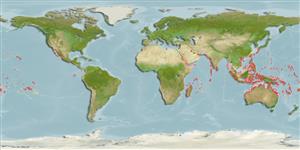Common names from other countries
>
Gobiiformes (Gobies) >
Gobiidae (Gobies) > Gobiinae
Etymology: Bathygobius: Greek, bathys = deep + Latin, gobius = gudgeon (Ref. 45335).
More on author: Bleeker.
Environment: milieu / climate zone / depth range / distribution range
Ecologie
marien; brak water rifbewoner; diepte 0 - 10 m (Ref. 48637), usually 0 - 2 m (Ref. 89972). Tropical; 32°N - 28°S
Indo-Pacific: East Africa to Johnston, Marquesas and Tuamoto islands, north to southern Japan, south to the southern Great Barrier Reef and Rapa Islands; Marianas and Marshall Islands in Micronesia. Misidentified as Bathygobius fuscus in Hawaii (Ref. 7490).
Grootte / Gewicht / Leeftijd
Maturity: Lm ? range ? - ? cm
Max length : 12.0 cm TL mannelijk / geslacht onbekend; (Ref. 11344)
Korte beschrijving
Determinatiesleutels | Morfologie | Morfometrie
Dorsale stekels (totaal) : 7; Dorsale zachte stralen (totaal) : 9; Anale stekels: 1; Anale zachte stralen: 8. Characterized by mottled brown overall color, with five alternating irregular whitish and brown blotches or saddles dorsally on body; lower half of side with 5-7 rectangular brown blotches; white spots and blotches on cheek and operculum; upper 4-5 pectoral rays branched to base, tips membrane-free; rounded caudal fin; longitudinal scale series 37-38; predorsal scales 10-12, nearly reaching to above rear margin of preopercle; scales absent on cheek and operculum; ctenoid body scales, becoming cycloid on abdomen, breast and nape; depressed head, width greater than depth; depth of body 5.0 in SL (Ref. 90102).
Lives among rubble, in sand pockets, or on reef rock and is abundant on silty intertidal reef flats (Ref. 9360, 58302). Benthic (Ref. 58302). Gut analysis composed of polychaetes, isopods, amphipods, and brachyurans (Ref. 9360, 48637).
Levenscyclus en paargedrag
Maturities | Voortplanting | Spawnings | Egg(s) | Fecundities | Larven
Myers, R.F., 1991. Micronesian reef fishes. Second Ed. Coral Graphics, Barrigada, Guam. 298 p. (Ref. 1602)
Status op de Rode Lijst van het IUCN (Ref. 130435)
CITES (Ref. 128078)
Not Evaluated
Gevaar voor de mens
Harmless
Gebruik door de mens
Visserij: commercieel; Aquarium: Commercieel
Tools
Speciale rapporten
Download XML
Internetbronnen
Estimates based on models
Preferred temperature (Ref.
115969): 24.7 - 29.3, mean 28.2 (based on 2826 cells).
Fylogenetische diversiteitsindex (Ref.
82804): PD
50 = 0.5000 [Uniqueness, from 0.5 = low to 2.0 = high].
Bayesian length-weight: a=0.00708 (0.00333 - 0.01504), b=3.09 (2.92 - 3.26), in cm Total Length, based on LWR estimates for this (Sub)family-body shape (Ref.
93245).
Trofisch niveau (Ref.
69278): 3.5 ±0.6 se; based on size and trophs of closest relatives
Weerstandsvermogen (Ref.
120179): Hoog, minimale populatieverdubbelingstijd minder dan 15 maanden (Preliminary K or Fecundity.).
Fishing Vulnerability (Ref.
59153): Low vulnerability (10 of 100).
